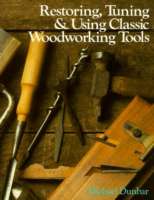

| Publisher | Sterling |
| Year | 1989 |
| ISBN | 0-8069-6670-X |
| Pages | 256 |
Charles L. Driggs
This is an introductory Galoot handbook of the highest order. First book I bought on tuning up old tools, well before the OldTools Porch even existed. Judging by comments on the Porch over the years, it was an early step on the path for many of those in our rockers. Excellent book for acquiring a basic understanding of old tools types and their uses, and how to get them working again if you're lucky enough to rescue one. This one is well worth the price, and is available new or used.
Robert Weber
Michael Dunbar's book is considered by many to be the primary reference for old tool restoration and usage. Having heard of this book since my introduction to galootdom, it was with great anticipation that I finally had the chance to read it.
The book is divided into five sections, each made up of 3 to 5 chapters. The first two sections on Tool Buying Guidelines and Tuning, Cleaning and Refinishing Tools are short. The tuning and cleaning section is covered in much more detail throughout the book, with references primarily back to the heat-treating chapter.
Following this short introductory material, we get into the meat of the book, old tools. The three tool sections are Bench Planes, Specialized Planes, and Miscellaneous Tools. Bench Planes is split up into three chapters dealing with woodies, metal planes and transitionals. These chapters begin with a short history of planemakers, what to look for in a used plane, what to avoid, and certain types to avoid because their collectability has driven their prices far beyond their usefulness as a tool. The author then spends time describing the various parts of a plane and how they typically differ from model to model.
Finally, he spends some time talking about how to recondition individual parts and entire planes, and then how to tune up and use a working model. In the chapter on transitionals, the author diverges from another well known old tool guru and mentor in that he believes these wooden bodied planes are an excellent value. He views them as the "orphans of the second-hand tool market." The lack of interest in them by collectors and lack of familiarity by woodworkers has lead to low prices. He recommends buying, tuning and using a transitional plane as a low-risk way to introduce one's self to the second-hand tool market.
The following section on specialized planes is the longest in the book. The author covers wooden molding planes such as hollows and rounds, wooden and metal special purposed planes, such as plow planes, dado planes, rabbet planes, and fillisters, and finally the complex and expensive combination planes. Other specialty planes covered include match planes, table leaf planes, and panel raising planes.
In the various parts on wooden molding and specialty planes, he gives us significant information on reconditioning the wooden bodies and regrinding or replacing the cutters. He is also quick to point out that despite his personal preference for wooden planes, there are several models of metal planes that do a similar job orders of magnitude better than there wooden counterparts. Examples of these include block planes, shoulder planes, and circular planes. The chapter on combination planes is limited to the Stanley #45, with which the author is most familiar.
The last chapter in specialty planes is Plane Related Tools, such as spokeshaves, drawknives and scrapers, scratch stocks and toothing planes. The section on spokeshaves is the most complete, although there is plenty of information throughout. Again the author displays a preference for wooden tools, although this time he has very practical reasons. A wooden spokeshave has a much lower cutting angle, leading to cleaner cuts and more control.
The last section on Miscellaneous Tools is divided into Chisels and Gouges, Saws, and Braces and Bits. The chisel and gouge section is a fairly straightforward exposition of chisel types (tang vs. socket, firmer vs. paring), how to replace handles, and sharpen and use chisels. If you don't know how to chop a mortise, you will when you finish this chapter.
The saw chapter is also straightforward, differentiating between hand and backsaws, crosscut and rip. There is a very brief paragraph on bow saws, and a page each on choosing, sharpening, and using a saw. Both the saw and the chisel chapter seem short and incomplete compared to the chapters on planes, but the tools themselves are so simple and straightforward that they are in fact covered in the same level of detail as all the other tools.
The last chapter in the book is about braces and bits. The author covers auger bits, center bits, spoon bits and gimlets. He gives tips on choosing, sharpening and using each of these types. Finally, the first appendix lists tools that the author recommends for basic, intermediate, and complete tool selections.
All in all, reading this book was a sheer pleasure for this neophyte galoot. The wealth of information gathered between these two covers is nothing but staggering. The amazing thing to me is how much more information there is about any single subject, such as saw sharpening, but those are covered more completely on various Internet sources, as well as books with a more sharply defined focus. This book should be on the shelf of anyone interested in purchasing used tools for the purpose of actually making something out of wood with them.